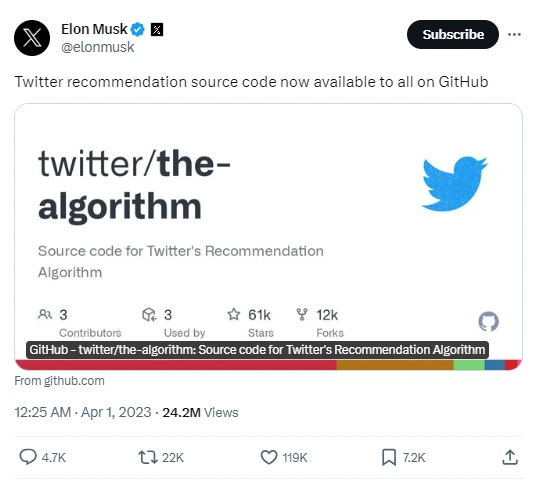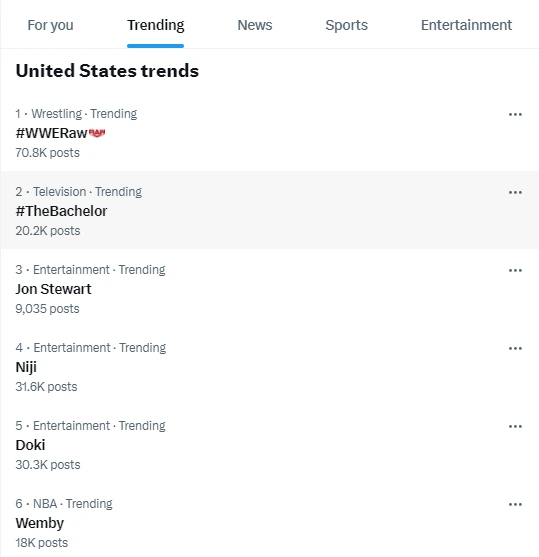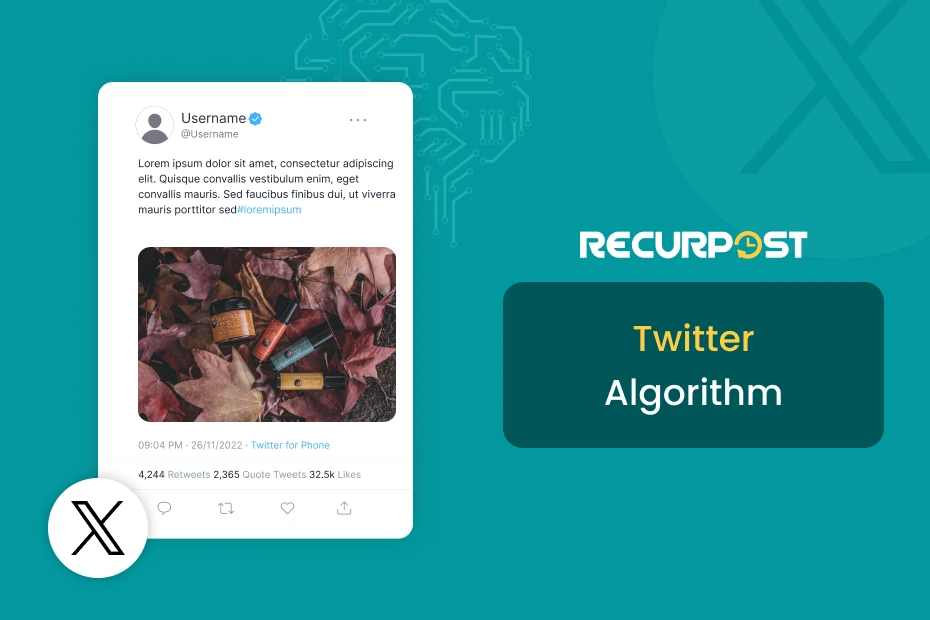Twitter can be tricky to understand and decode, but with proper use of the Twitter algorithm, you can not only master it but also use it to your full advantage in no time!
Ever wondered why some tweets seem to get all the attention, while others barely make a splash? It’s all about understanding the Twitter Algorithm.
This clever system decides which tweets show up in our feeds and in what order. Think of it as a helpful friend who sorts through tons of tweets to show us what we’ll probably like the most.
If you’re hoping to make your tweets more popular and reach more people, getting to know how Twitter algorithm works can be a game-changer.
Let’s dive in together and unlock the secrets to making your tweets stand out!
Understanding the Twitter Algorithm

[Source: Twitter]
Twitter’s algorithm has evolved dramatically over the years. Originally tweets were just displayed in pure reverse chronological order – the newest ones first. However as more tweets flooded users’ timelines, it became ineffective. Relevant content was lost.
So Twitter introduced algorithms influencing tweet visibility. They utilize machine learning to analyze factors like interactions and determine which tweets might interest specific users. The goal is relevance – showing each user what matters most at that moment.
As of 2024, Twitter displays five types of tweets, adjusted by proprietary algorithms:
Twitter feed algorithm
The Twitter feed algorithm curates and ranks tweets predicted to interest you most from those you follow. It considers factors like recency, interactions, location, interests, and behaviors over time.
Twitter trending algorithm
These are promoted tweets getting strong current engagement from your wider network. This surfaces timely, relevant viral conversations. And there is no doubt to the fact that better a tweet trends, more is its reach across the platform.
Twitter Recommendation algorithm
These suggest content from accounts you don’t follow which the Twitter recommendation algorithm determines may interest you based on your interactions with topics, links, and terms. It is basically to broaden the horizon of an account and also connect it to more people.
Twitter search algorithm
Through the Twitter search algorithm, the system uses various factors like keywords, hashtags, media and engagement to give results to the search operations that the user does on it. It is best to be specific in order to get the best results.
So Twitter balances relevance through algorithms by showing users some timely, widely-shared content as well as suggestions to tailor the experience. Mastering these algorithms leads to higher tweet visibility and more of the right connections.
Interesting Fact: The source code for the Twitter Algorithm is available for all on GitHub.
Analytics: It is of utmost importance to regularly monitor your tweet performance using Twitter analytics or third-party tools. Modify your strategy according to what works for you best.

How to use Twitter algorithm
Twitter’s algorithm is complex, but these core factors have an outsized influence in determining tweet visibility:
1. User Interactions
The #1 factor Twitter tracks is user interactions with tweets. This includes likes, retweets, replies, follows, link clicks, hashtags, embedded media views, and profile visits driven by the tweet. The more interactions a tweet gets, the more likely it is to be seen by others. It’s like telling the algorithm, “Hey, this tweet is interesting!”
2. The uniqueness of Tweets
Tweets that offer something new or different catch the algorithm’s eye. If your tweet sounds like a fresh conversation starter, it’s got a better chance of being noticed.
3. Post Timings
When you tweet, it can impact initial visibility momentum. The algorithm detects rising conversations by engagement and may promote fast-moving tweets. Initial visibility lifts future visibility.
4. User Behavior
The algorithm pays attention to what you like to see. If you often interact with certain types of tweets or accounts, the algorithm tries to show you more of those.
5. Ongoing Behavior Patterns
The algorithm customizes your feed based on past behaviors. Things like your follow, retweets, locations, hashtags used, links clicked, and keyword interactions help determine future relevance.
6. Content Quality
Also, it is crucial to avoid posting spammy or abusive content. The algorithm filters out low-quality tweets and can penalize accounts that engage in such behavior. To know more about the same, it is most appropriate to read twitter’s spam policies for further information.
Based on our research, it appears that tweets containing links might not perform as well in terms of visibility and engagement. This could be due to the algorithm prioritizing content that keeps users engaged within the platform rather than directing them away.
Furthermore, our findings suggest that paid accounts tend to have a higher reach compared to free accounts, possibly because of the added features and promotional tools available to paid users that can amplify their content’s reach.

By understanding these key factors, you can craft tweets that resonate with your audience, and spark meaningful interactions that ultimately unlock broader visibility on Twitter.
Building and Connecting with the Right Audience
Twitter isn’t just about broadcasting your message, it’s about connecting with the right people who resonate with your voice and content. Here’s how to make that happen:
Identifying Your Target Audience
- Define your goals: Are you building brand awareness, driving sales, or fostering community? Knowing your objectives helps shape your audience’s focus.
- Research relevant hashtags: Explore hashtags related to your niche and analyze who engages with them. These users are potential audience members.
Connecting and Engaging
- Craft a compelling Twitter bio: Highlight your value proposition and target audience.
- Respond to comments and mentions: Promptly and genuinely respond to any interaction, building positive relationships.
Utilizing Twitter Analytics
- Dive into your audience demographics: Understand their age, location, and interests to tailor your content accordingly.
- Analyze tweet performance: To track what resonates most with your audience, and schedule tweets based on those insights to inform your future content strategy.
Leveraging Twitter Lists and Communities
- Create targeted lists: Organize your target audience into categorized lists for focused engagement, like industry influencers or potential customers.
- Join relevant communities: Twitter Communities offer focused groups around specific interests. Find and join communities aligning with your niche to connect with like-minded users.
- Run Twitter polls and Q&As: Gather valuable insights and foster dialogue directly with your target audience.
By keeping these changes in mind and tweaking your Twitter strategy accordingly, you can maintain and even boost your tweet visibility and engagement. Remember, it’s all about promoting genuine interactions and sharing content that resonates with your audience.
The Impact of Recent Twitter Algorithm Changes 2024
Twitter is always tweaking things under the hood to make our experience better. Here are some recent updates and how to optimize for them:
Increased Topic Focus
Twitter now boosts tweets about breaking news and events getting strong traction globally. It also spots rising topics gaining momentum in specific user communities and locations.
Strategies: Use trending hashtags wisely when truly relevant. Tweet about timely topics your audience connects with.

Faster Refresh Rates
Users now see tweets refreshed much more frequently instead of static home timelines when opening the app. This means more opportunities for ongoing tweets to capture attention.
Strategies: Post at various times of day to increase impressions. Check analytics for when your followers are most active.
Curation of Quality Content
Their algorithms are now removing extreme, upsetting, or harmful tweet content, as well as false influencer tweets. Elaborate discussion and genuinely intriguing knowledge are more valued.
Strategies: Provide analysis and well-articulated takes vs reactions. Foster dialogue through thoughtful replies.
The key is recognizing Twitter values relevance, quality, and healthy user experiences. Align your approach with this, continuously adapt to updates, and algorithms will work for you rather than against you.
Strategies for gaining visibility and engagement
Boosting your tweets’ performance isn’t just about luck, it’s about strategy. Here are some smart moves to help your tweets shine and capture the attention they deserve:
1. Analyze Ideal Posting Times
Use Twitter analytics to reveal when your followers are most active. Test posting at various times and days to determine what resonates best. Consistency also helps build anticipation.
To get the best posting time, you can refer to our blog – Best Time to Post on Twitter
2. Ask Good Questions
Pose intriguing questions to spark dialogue rather than just statements. Align them to trending topics and your followers’ interests. Questions are the most retweetable format.

3. Include Quality Visuals
Tweets with images, charts, memes, or short videos tend to perform better as they catch the eye while scrolling. Ensure they further amplify your message.

4. Leverage Trending Hashtags
Research related hashtags that are organically trending around your topics and followers’ conversations. Use judiciously in tweets to tap into this momentum.

5. Reply and Retweet Followers
Actively listen and engage with your followers and mentions through @ replies, likes, and retweets. This nurtures a community and loyal audience.

Fine-tuning these strategies based on your performance analytics over time. The users have spoken – give them more of what they love!
Recommend: Tips for growing and engaging your audience on X
Common Myths vs. Facts About the Twitter Algorithm
There are many misconceptions about how Twitter’s algorithm works. But myths lead to misguided strategies. Let’s clear up some common fallacies with facts:
Myth 1: A high follower count is most important for reach.
Fact: Your number of followers has little direct impact on tweet visibility. Engagement rates on each tweet drive impressions and recommendations much more. Someone with 100,000 followers but low interaction has less reach than a smaller account with consistently higher engagement.
Myth 2: Using the most popular hashtags expands visibility.
Fact: Generic heavily used hashtags get drowned out. But niche-relevant hashtags aligning to specific active conversations around your topic can lift visibility. Research and test these.
Myth 3: Twitter only shows tweets from accounts I follow.
Fact: The algorithm factors in engagement on any given tweet across the platform. If a tweet from an account you don’t follow strikes a chord in the moment, Twitter may highlight it in your timeline or notifications.
Myth 4: My tweet activity alone controls visibility.
Fact: Who sees your tweets depends greatly on their interests and behaviors over time. Cater content to what attracts their engagement specifically.
Focus activity on driving genuine engagement aligned with audience interests rather than vanity or assumptions. Let go of myths for reality-based algorithm optimization!
Value: Ensure your content is valuable, interesting, and relevant to your audience. Avoid posting just to fill the timeline; every tweet should have a purpose.
Tools and Resources for Mastering the Twitter Algorithm
To truly get ahead on Twitter and make the algorithm work for you, it’s smart to arm yourself with the right tools and resources. Here’s a guide to some of the best out there:
Analyzing Your Performance
- Twitter Analytics: The built-in platform offers valuable insights into tweet performance, audience demographics, and engagement metrics. Utilize it to understand what resonates and adapt accordingly.
- RecurPost: Schedule posts on Twitter strategically based on peak activity times and analyze performance reports to optimize your posting rhythm.

Staying Informed and Adapting
- Twitter Blog: Stay updated on official algorithm changes and platform updates directly from the source.
- Follow Tech News: Tech news websites like TechCrunch, The Verge, and Wired regularly cover updates from major social media platforms, including Twitter. These sites offer in-depth analyses of new features and changes, helping you understand the potential impacts on your Twitter strategy.

Additional Resources
- Twitter Help Center: Get answers to frequently asked questions, troubleshoot technical issues, and learn about Twitter features directly from the official help center.
- Twitter Communities: Join communities focused on social media marketing or your specific niche to learn from other users, share experiences, and gain insights into the latest trends.

Explore these tools and resources, experiment strategically, and stay informed about updates. By consistently analyzing your performance, adapting your approach, and using the right resources, you can unlock the full potential of Twitter and achieve your goals on the platform.
Conclusion
Navigating the Twitter Algorithm might seem daunting at first, but it’s definitely manageable with the right approach. Remember, the heart of Twitter is engagement. By focusing on creating content that resonates with your audience, encouraging interactions, and using the right tools to refine your strategy, you’ll not only master the algorithm but also see your Twitter presence flourish.
Most importantly, be patient and persistent. Building a successful Twitter presence takes time and effort. By consistently creating valuable content, fostering genuine interactions, and embracing continuous learning, you can unlock the true potential of Twitter and achieve your goals on the platform.
Frequently Asked Questions
Twitter certainly has an algorithm, much like every other social media application. And this algorithm does not comprise of one but rather several more algorithms making it a whole.
The primary source for Twitter algorithm to show you your desired tweets is taking note of the kind of tweets that you seem to take interest in while browsing. So, if you wish to reset it, it is most advisable to alter your interests.
Hashtags generally help a platform categorize various topics into categories. But more than that, it helps the person who uses the hashtag for a particular tweet reach the kind of audience that the tweet was made or dedicated to.
Twitter analytics provide insights into how your content performs, showing metrics like impressions, engagements, and follower growth. Analyzing these metrics helps identify what content resonates with your audience.
Early mornings between 9 to 12 and in the evening between 5 to 6 on Tuesdays and Wednesdays are generally effective times for posting on Twitter, as people often check their feeds when they start or end their day.
To reach the right audience, focus on creating content that resonates with your target demographic. Use targeted hashtags, engage in conversations relevant to your niche, and follow and interact with users and influencers within your industry.
Social media platforms frequently update their algorithms to improve user experience and ensure content relevancy. Staying informed about these changes through official Twitter updates or social media news sources can help you adapt your strategy.

Saurabh Chaturvedi is a content writer at RecurPost. Specializing in social media management and marketing, Saurabh is dedicated to crafting engaging and informative articles. His passion for clear, exciting content keeps readers eager for more.
